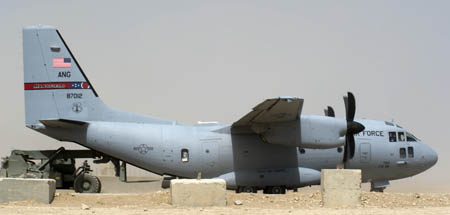While  the Air Force leadership seeks to divest the C-27J airlift fleet in Fiscal 2013, saying it cannot afford to keep these aircraft given tightening budgets, the tiny transports are earning high marks from operators in Afghanistan. “While the US Air Force standard mission tasking process requires 96 hours of notice, the C-27J has been ‘time on target’ in less than 24 hours, while operating under Army tactical control,” said Capt. Steffen Landrum, the 702nd Expeditionary Airlift Squadron’s liaison officer to the Army’s 25th Combat Aviation Brigade, in an Army news report posted on April 23. Landrum added, “For the troops out in the field, that is the ultimate flexibility.” C-27Js have been operating out of Kandahar Airfield since August 2011 as part of the 702nd EAS. Based on Landrum’s calculations, the Army has saved $30 million during this span by fulfilling some missions with C-27Js instead of CH-47 Chinook helicopters, and the Air Force has saved “more than $3.8 million” by not having to operate strictly C-130s in direct-support roles. The C-27J is “by far the better choice for the last tactical mile,” said Lt. Col. Jeffrey Charette, 702nd EAS director of operations. House defense authorizers will mark up the Pentagon’s Fiscal 2013 budget request later this week, potentially weighing in on the C-27J’s fate. Army Chief of Staff Gen. Raymond Odierno has expressed interest in retaining the 21 C-27s already in the fleet. Further, the Coast Guard reportedly is also interested in acquiring the airframes. (Kandahar report by Richard Barker)
the Air Force leadership seeks to divest the C-27J airlift fleet in Fiscal 2013, saying it cannot afford to keep these aircraft given tightening budgets, the tiny transports are earning high marks from operators in Afghanistan. “While the US Air Force standard mission tasking process requires 96 hours of notice, the C-27J has been ‘time on target’ in less than 24 hours, while operating under Army tactical control,” said Capt. Steffen Landrum, the 702nd Expeditionary Airlift Squadron’s liaison officer to the Army’s 25th Combat Aviation Brigade, in an Army news report posted on April 23. Landrum added, “For the troops out in the field, that is the ultimate flexibility.” C-27Js have been operating out of Kandahar Airfield since August 2011 as part of the 702nd EAS. Based on Landrum’s calculations, the Army has saved $30 million during this span by fulfilling some missions with C-27Js instead of CH-47 Chinook helicopters, and the Air Force has saved “more than $3.8 million” by not having to operate strictly C-130s in direct-support roles. The C-27J is “by far the better choice for the last tactical mile,” said Lt. Col. Jeffrey Charette, 702nd EAS director of operations. House defense authorizers will mark up the Pentagon’s Fiscal 2013 budget request later this week, potentially weighing in on the C-27J’s fate. Army Chief of Staff Gen. Raymond Odierno has expressed interest in retaining the 21 C-27s already in the fleet. Further, the Coast Guard reportedly is also interested in acquiring the airframes. (Kandahar report by Richard Barker)
House, Senate Unveil Competing Proposals for 2026 Budget
July 11, 2025
Lawmakers from the House and Senate laid out competing versions of the annual defense policy bill on July 11, with vastly different potential outcomes for some of the Air Force’s most embattled programs.